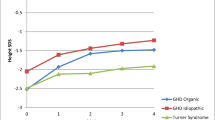Abstract
Objective: The aim of this study is to estimate the annual incidence and prevalence rate of the GH treatment exposure in patients under the age of 18 treated for hypopituitarism or isolated GH deficiency (GHD) in Piedmont, during the period January 1, 2002 to December 31, 2004. Methods: The selection criteria for recombinant human GH (rhGH) treatment in childhood were approved by the Ministry of Health in Italy in the yr 1998. The present analysis is based on data from the Registry of subjects receiving GH therapy (GH Registry) made up of the 918 pediatric patients (age <18 yr) with a diagnosis of GHD (excluding Prader-Willi and Turner syndromes and other conditions), diagnosed in the period January 1, 2002–December 31, 2004. The case series has been described as regards the number of cases per year of diagnosis; the prevalence and incidence rates, calculated per 10,000 (‱) inhabitants, are given for each year of the study period. Results: The prevalence rate increases slightly from 8.62‱ in 2002 to 9.44‱ in 2004 and the incidence rates estimated were 2.49‱, 1.86‱ and 1.97‱ in the yr 2002, 2003 and 2004, respectively. Conclusion: The Piedmont GH Registry represents the first database available in Italy and could set an example for the other Italian regions as well.
Similar content being viewed by others
References
GH Research Society. Consensus guidelines for the diagnosis and treatment of adults with growth hormone deficiency: summary statement of the growth hormone research society workshop on adult growth hormone deficiency. J Clin Endocrinol Metab 1998, 83: 379–81.
GH Research Society. Consensus guidelines forthe diagnosis and treatment of growth hormone (GH) deficiency in childhood and adolescence: summary statement of the GH research society. J Clin Endocrinol Metab 2000, 85: 3990–3.
Erfurth EM, Bengtsson BA, Christiansen JS, Bulow B, Hagmar L. Premature mortality and hypopituitarism. Lancet 2001, 357: 1972–4.
Bulow B, Hagmar L, Orbaek P, Osterberg K, Erfurth EM. High incidence of mental disorders, reduced mental well-being and cognitive function in hypopituitary women with GH deficiency treated for pituitary disease. Clin Endocrinol (Oxf) 2002, 56: 183–93.
Bulow B, Hagmar L, Mikoczy Z, Nordstrom CH, Erfurth EM. Increased cerebrovascular mortality in patients with hypopituitarism. Clin Endocrinol (Oxf) 1997, 46: 75–81.
Wyatt D. Lessons from the national cooperative growth study. Eur J Endocrinol 2004, 151(Suppl 1): S55–9.
Guyda HJ. Four decades of growth hormone therapy for short children: what have we achieved? J Clin Endocrinol Metab 2005, 84: 4307–16.
Ranke MB, Wilton P. Growth hormone therapy in KIGS-10 years’ experience. Barth Verlag Heidelberg Leipzig 1999, 10–20.
Parkin JM. Incidence of growth hormone deficiency. Arch Dis Child 1974, 49: 904–5.
Lindsay R, Feldkamp M, Harris D, Robertson J, Rallison M. Utah Growth Study: growth standards and the prevalence of growth hormone deficiency. J Pediatr 1994, 125: 29–35.
Thomas M, Massa G, Craen M, et al. Prevalence and demographic features of childhood growth hormone deficiency in Belgium during the period 1986–2001. Eur J Endocrinol 2004, 151: 67–72.
Regal M, Paramo C, Sierra SM, Garcia-Mayor RV. Prevalence and incidence of hypopituitarism in an adult Caucasian population in northwestern Spain. Clin Endocrinol (Oxf) 2001, 55: 735–40.
Coste J, Letrait M, Carel JC, et al. Long-term results of growth hormone treatment in France in children of short stature: population, register based study. BMJ 1997, 315: 708–13.
Gazzetta Ufficiale n. 7 del 10 gennaio 2001 — Ministero della Sanità.
Altman DG, Machin D, Bryant T, Gardner MJ. Statistics with confidence. Bristol: BMJ Books. 2000.
La Banca Dati Demografica Evolutiva della Regione Piemonte: http://www.regione.piemonte.it/stat/bdde/index.htm
Supplemento ordinario alla “Gazzetta Ufficiale” no 259 del 4 novembre 2004-Ministero della Sanità; Note AIFA 2004 (Revisione Note CUF).
NOTE AIFA - http://www.simg.it/news/farmaco/note/Note_Aifa_2004.pdf
Author information
Authors and Affiliations
Corresponding author
Rights and permissions
About this article
Cite this article
Migliaretti, G., Aimaretti, G., Borraccino, A. et al. Incidence and prevalence rate estimation of GH treatment exposure in Piedmont pediatric population in the years 2002–2004: Data from the GH Registry. J Endocrinol Invest 29, 438–442 (2006). https://doi.org/10.1007/BF03344127
Accepted:
Published:
Issue Date:
DOI: https://doi.org/10.1007/BF03344127




